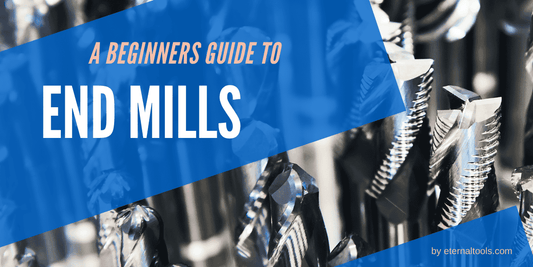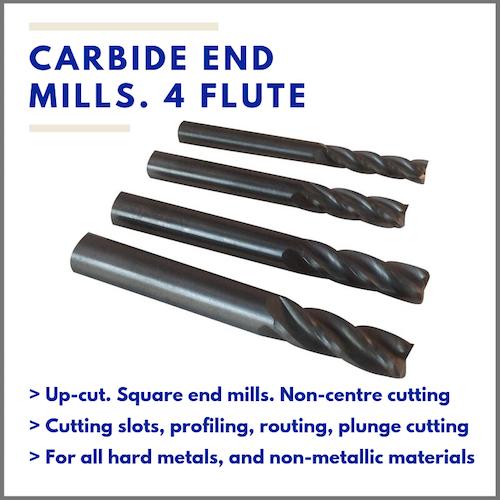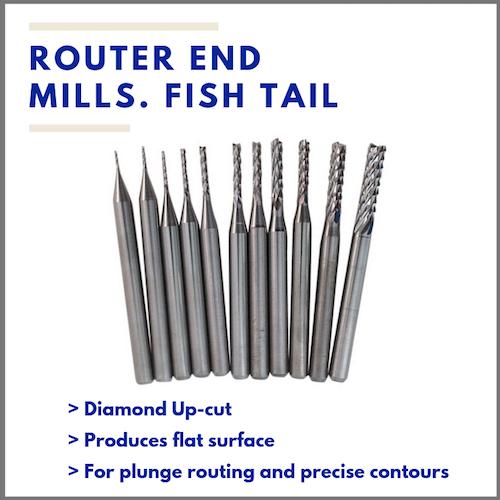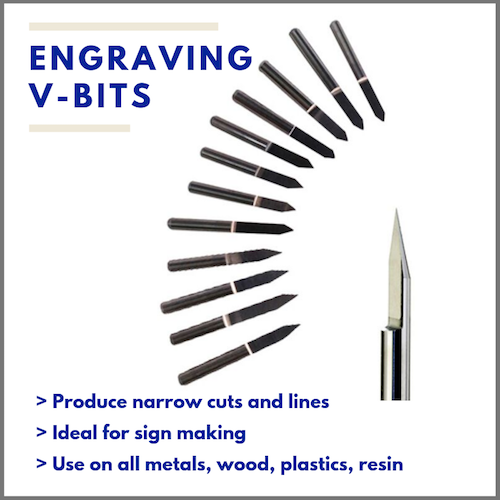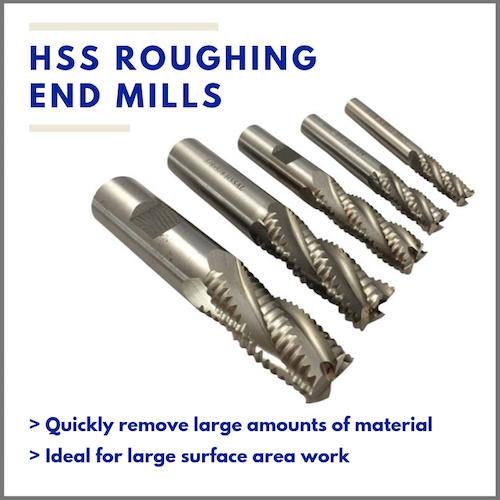End mills, slot drills, routers, milling cutters, drill bits, V-bits and burrs - what does it all mean?
And which bit do I need for what job? For instance, which are the best end mills? and which is the best end mill for aluminium, and which are the best end mill for stainless steel.
This article gives you the low down on milling cutters and CNC tooling and the right tools for the job.
What is a CNC Machine?
Milling cutters, or endmills, are used in a CNC machine and machine shops: Computerised Numeral Controlled.
Specialised software is used to send automated milling instructions or a ‘toolpath’ to the machine which then cuts away a design in your stock material.
The craft market has recently exploded with exciting compact, tabletop CNC Routers and Mini-milling machines. CNC Routers are now affordable enough to allow DIY enthusiasts access to this high-precision milling tool for carving and engraving.

What if I don’t have a CNC machine?
Endmills, routers and milling cutters are those used in a CNC machine, but if you don’t have a CNC machine then you can use Burrs in a rotary tool.
Burrs are available in carbide, steel and diamond.
To Drill or To Mill?
Just about any material can be cut using a CNC machine. Popular materials are metals, plastics and wood.
So why use an Endmill and not a drill bit? In short, a drill bit moves up and down, and an end mill moves side-to-side (Note: there are endmills available that move in all directions).
End Mills
1. End Mills cut rotationally in a horizontal, or lateral (side to side) direction whereas a drill bit only cuts straight down, vertically into the material.
2. Endmills are available in a wide variety of lengths, diameters, flutes and types, and are chosen according to the material they are cutting and the surface finish required for the project.
3. End mills are the cutters of the milling world and are used for slotting, profiling, contouring, counter-boring, and reaming.
4. End mills allow for precision parts to be cut, anything from machine parts, jewellery designs, wood engravings, sign making, plastic cutting, mold making and circuit boards.
Drill Bits
1. Drill Bits cut round holes straight down into the material by rotating them in a rotary drill.
2. Most drill bits have a spiral groove (flutes) which gives the drill bits a twisted appearance and helps to cut away material as they move up and down in the hole.
3. HSS (High-Speed Steel) and carbide drill bits are fluted. (twist drills)
4. The exception to this rule is diamond drill bits which have a flat end rather than pointed or fluted. (Unless it is a diamond twist drill which is not used for drilling but for expanding already existing holes such as in beads)
End Mill Flutes - What Are They, and How Many Do I Need?
The Spiral-shaped cutting edges on the side of the end mill are called flutes.
The helix angle is the space between the cutting edge and the centre of the tool, so the length of cut if you like. The larger the helix angle the more likely it is to be used on softer materials, the smaller the angle the more likely it is to be used on harder and stronger materials.
Flutes provide an empty path for the cutting chips to escape from when the end mill is rotating in a workpiece.
End Mills have either 2, 3 or 4 flutes per bit. 2 and 4 flutes are the most popular.
Chamfer Mills are used to bevel a wide range of materials, sometimes referred to as countersinks. They will grind and smooth centre holes, deburr, bevel, and countersink on various applications.
2 Flute End Mills (Slot drills):
- For use on wood and aluminium
- Fewer flutes are best for chip evacuation, keeping the bit cooler, but leaving a rougher surface cut.
- 2 flutes are best for use on Wood and aluminium as these produce very large chips in comparison to other materials.
- 2 flute end mills are also referred to as slot drills.
4 Flute End Mills:
- For use on most other materials
- 4 flute end mills are used on most other materials, can cut harder materials than 2 flutes and will create an overall smoother surface finish.
End Mill Shapes and Sizes:
There are multiple types of End mills, each designed with a variety of different factors to enable you to choose the right end mill to match the material you’re working on, and the type of project you’re going to use it for.
Router End Mills - Fish Tail
Fish tail points prevent any splintering or breakout and will plunge directly into your material producing a flat surface.
These Router End Mills are ideal for plunge routing and producing precise contours – making them ideal for sign making and metal forming.
For an excellent finish, choose a diamond up-cut as these have an abundance of cutting edges.
Engraving V-Bits
V-bits produce a “V” shaped pass and are used for engraving, particularly for making signs.
They come in a range of angles and tip diameters. The small angles and tips provided on these V-shaped engraving bits produce narrow cuts and small, delicate engraving of lettering and lines. Available on a 6mm shank, or a 3mm shank.
Ball Nose End Mills
Ball nose mills have a radius at the bottom which makes for a nicer surface finish in your workpiece, meaning less work for you as the piece won’t need to be finished any further.
They are used for contour milling, shallow slotting, pocketing and contouring applications.
Ball nose mills are ideal for 3D contouring because they are less prone to chipping and leave a nice rounded edge.
Tip: Use a Roughing end mill first to remove large areas of material then proceed with a ball nose end mill.
Roughing End Mills
Great for large surface area work, roughing end mills have numerous serrations (teeth) in the flutes to quickly remove large amounts of material, leaving a rough finish.
They are sometimes referred to as Corn Cob cutters, or Hog Mills - so-called after the pig who ‘grinds’ away, or consumes, anything in its path, meaning they have high material removal rates.
Available in both metric sizes and imperial sizes.
Straight Router Bits
These TCT Straight Routers have extremely sharp cutting edges for plunge cutting, routing grooves, cutting dados, rabbeting and mortising and will achieve a clean, smooth, high quality surface finish.
Wonderful for use on a wide range of applications on plywood, hardwood, fibreboard, chipboard, softwood, PVC, plastics, acrylics, ABS, MDF, PMMA and more.
Square End Mills
Commonly referred to as Flat End Mills, square-end mills produce a sharp edge at the bottom of the slots and pockets of the workpiece.
They are used for general milling applications including slotting, profiling and plunge cutting.
Corner Radius End Mills
Similar to square end mills/flat end mills but these have a round cutting edge also known as bull nose (not to be confused with Ball nose as mentioned above).
They are less prone to chipping and generally have a longer tool life.
Should I Use Carbide End Mills or HSS End Mills?
Most end mills are manufactured from either cobalt steel alloys – referred to as HSS (High Speed Steel), or from tungsten carbide.
The choice of material for your selected end mill will depend on the hardness of your workpiece and the maximum spindle speed of your machine. A solid carbide end mill will give the best performance, with high accuracy, can be used at higher feed rates, and benefits from a long tool life due to the strength of tungsten carbide.
High Speed Steel End Mills (HSS)
HSS end mills come at a cheaper price, but do not offer the high efficiency, high performance, tool life, or speed capacity of solid carbide end mills.
Cobalt End Mills
Cobalt end mills come at a higher price than HSS but provide high-efficiency milling, better wear resistance and toughness.
Solid Carbide End Mills
Solid Carbide end mills are considerably harder, rigid, and more wear-resistant than others.
Carbide end mills are extremely heat-resistant and used for high-speed applications on some of the hardest materials such as cast iron, non-ferrous metals, alloys and plastics. They have an excellent performance rate and abrasion resistance and can be used on a wide variety of materials.
End Mill Coatings
Endmills with added chemical coatings are also popular today.
Often more expensive, these coatings are added to the bit to reduce wear and friction. However, not all coatings are suitable for all materials and whilst a particular coating may be good for productivity on one material, it may not be on another.
Popular coatings are Aluminum Titanium Nitride (AlTiN) and Titanium Diboride (TiB2)
End Mill Cut Varieties:
- Centre-cutting end mills are those that can be plunged straight down into the material. They can mill, and they can drill. (They have cutting edges on the end face and the sides) These are usually the 2 flutes or 3 flute endmills, and occasionally you can find some 4 flutes that are centre cutting as well.
- Non-centre cutting end mills refers to those that mill, they do not drill. (they have cutting edges only on the sides)
- Up-cut end mills eject chips towards the top of the workpiece, leaving a cleanly cut bottom surface inside your material.
- Down-cut end mills do the opposite, they leave a smooth top surface on your material.
- Compression end mills combine the best of both worlds and produce a smooth surface on both ends of the workpiece when cutting.
Starter Pack End Mills
So what type of end mills do you require for general milling applications?
- For hardwoods, plywood and aluminium: High-quality 2-flute (slot drills) up-cut and down-cut end mills.
- For 3D contours and profiling: 2-flute ball nose end mills
- For sign-making and routing of plastics, acrylics and metals: Carbide Router end mills. and carbide engraving v-bits
Troubleshooting Tips for working with End Mills
- Selecting the right tooling for your material and project will improve the quality of your work and reduce the need for excessive hand-finishing.
- The feed rate of the material must be matched to the optimal speed of the end mill.
- A 50% reduction in operating speed can double the life span of your end mill.
- Choose the correct flute count for the application - proper chip evacuation is crucial as heated cutters can lead to low-quality cutting (burnt material, burred edging and dull tooling).
- Use carbide end mills for harder materials and high production applications.
- Sometimes extra length end mills are necessary to use, but to combat deflection (bending of the bit) operate at the proper speed and feed rates and always use the most rigid (shortest and widest) end mill available for the application.
- Double check you have the right tool for the job before starting i.e.: Different sizes, flute length and shank diameter necessary for the job to hand.
- Use coolant or compressed air to prevent chip build-up.
- Use the whole side of the cutting edges rather than a small portion towards the tip. This will improve the shelf life of your endmill as the heat and work are distributed over a larger surface area.
End Mill Speeds
- RPM (Revoltions Per Minute) = 3.82 x SFM (Surface Feet per Minute) ÷ endmill diameter
- SFM = endmill diameter x RPM ÷ 3.82
- IPM (Inches Per Minute) = RPM x number of flutes x Chip Load
- Chip Load = IPM ÷ RPM x number of flutes.

